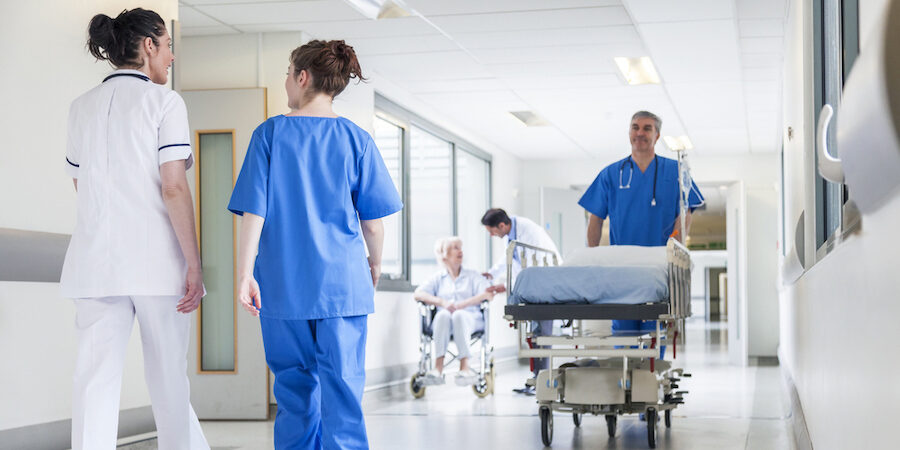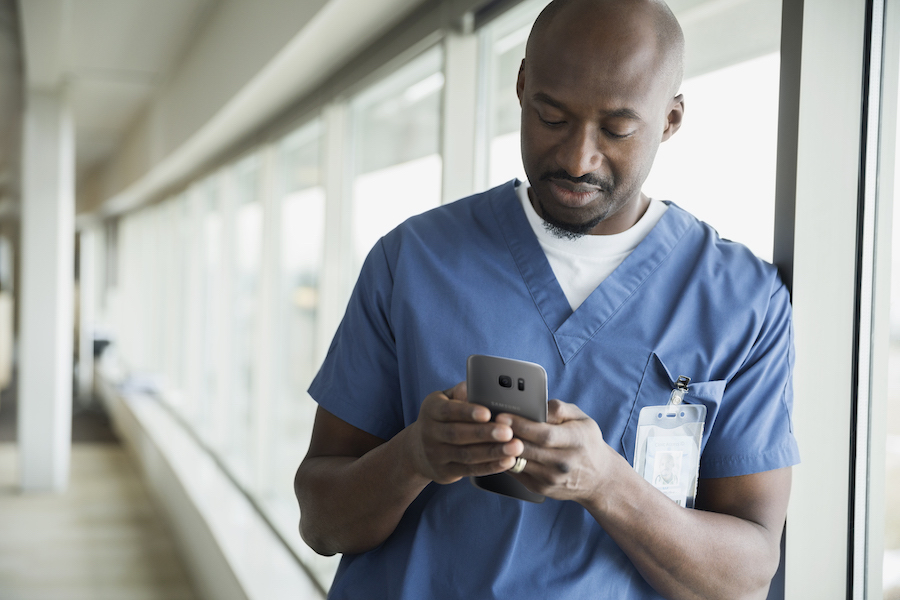As a registered nurse for 25 years, Darlene Duncan has seen digital technology transform healthcare. Surgeries have become less invasive, electronic patient monitoring has gotten smarter, and medical records are all now digital. But when it comes to clinical communications, Duncan feels like she’s stuck in the ’90s.
Duncan carries three separate work devices: a beeper, a charge nurse flip phone and a voice-activated device for locating her team. None of these devices enables electronic health record (EHR) access or real-time communication with physicians. Duncan says clinicians need one sole source device that lets them talk, text and access information on the fly. Simply put, to consolidate and communicate effectively, they need secure smartphones.
“Our greatest continuing challenge is timely communication,” says Duncan, a nurse manager at a large Level I trauma center. “I need one sole source device to communicate with my staff and physicians, and to interface with the EHR. Instead, I have all three devices, all the time, physically attached to me. Even the physicians in our hospital use a very antiquated beeper system.”
Without the benefit of secure mobile clinical communications, clinicians like Duncan face several specific challenges:
1. Delayed nurse/physician communication
Ninety percent of hospitals still use pagers for clinical communications, according to HIMSS Analytics. These systems cost about 45 percent more than hospitals would have to pay for smartphone-based unified communications. Worse, pagers slow down clinicians and can delay patient care.
“Sometimes I don’t even need the doctor to call me back,” says Duncan. “I just need to inform him about something, but I have to page him, and he has to stop and call me, and I have to stop what I’m doing to answer the phone. Other times, I have a patient in a critical state and I need the doctor now. If I could call or text directly, it would save time and potentially lives.”
Delayed nurse/physician communication also affects the patient experience, Duncan says. “If I say, ‘Let me call the doctor, I’ll be back in five minutes,’ and it takes 30 minutes, there goes a little bit of those patient satisfaction scores, which directly affects reimbursement through HCAHPS scores.”
2. No mobile EHR access
Healthcare is an inherently mobile profession, with doctors bouncing from hospital to clinic, and nurses rushing from one patient room to another. Yet, in many hospitals, communication is anything but mobile. Instead, clinicians can only access patient medical records from shared computers in hallways or nurses stations. That amounts to a significant amount of wasted time, delays in updating information and excessive charting.
By enabling secure mobile EHR, smartphones allow clinicians to access and edit patient records directly from the bedside. This ensures patient information is always up to date and nurses save time on charting later.
“Currently, I’m sitting in front of the computer and charting at least 50 to 60 percent of each 12-hour shift,” says Duncan. “With mobile EHR access, I would easily save at least an hour a day.”
3. Alarm fatigue
During a hospital stay, patients have a lot of needs. Sometimes they just need an extra pillow or help going to the bathroom. Other times, they need immediate life-saving assistance. But in many cases, nurses have to physically go to the patient’s room to determine if they need medical attention or if another staff member can help. This wastes precious time and can lead to alarm fatigue.
In most hospitals, the staff hears tens of thousands of alarms per day, says the Joint Commission. Between 85 and 99 percent of those alarms don’t require medical attention, and the volume of alarms can distract and desensitize nursing staff, leading to delays in care.
With smartphones and tablets, nurses can simply call a patient’s room to ask what they need. Many mobile communication solutions can even be integrated with bedside equipment and nurse call systems to filter out false alarms, prioritize patient requests and send the most urgent alarms directly to nurses’ smartphones.
4. Medical errors
Care providers are only human. Between staffing shortages and communications overload, it’s easy to see how mistakes happen in busy hospitals. Medical errors are the third leading cause of death in the U.S., contributing to 250,000 deaths each year, according to Johns Hopkins.
Any way hospitals can alleviate this overload and automate clinician workflows can help prevent tragic and costly medical errors. For example, smartphones with integrated barcode scanners can support positive ID applications such as barcoding medication administration, which alerts clinicians when they’re about to give a patient the wrong medication or medication that isn’t yet due.
How smart are your clinical communications?
Take this quick assessment to evaluate your hospital's technology use and get personalized advice. Download Now
Effective hospital communication is worth the investment. “Budgets are tight for all hospitals right now,” says Duncan, “but all it takes is one misstep, one patient to die because of a lack of communication, and that’s a loss that costs much more than smartphones” — not to mention the potential legal fallout.
5. Security breaches and HIPAA violations
Nurses know that more effective clinical communication is possible, if only they were allowed to use their smartphones. However, when care providers use their personal phones for clinical communications, they’re more likely to violate Health Insurance Portability and Accountability Act (HIPAA) regulations by sharing patient information via an unsecured channel or network. Lost, stolen or hacked personal devices can also lead to costly data breaches.
More than half of the healthcare vendors surveyed for the 2020 Ponemon study Are Risk Assessments Failing to Secure the Third-Party Healthcare Ecosystem? reported experiencing data breaches that exposed protected health information (PHI) belonging to health organizations they serve. That’s why some leading hospitals are empowering their teams with secure clinical communications solutions that deliver the benefits of mobile, without the additional risks.
Duncan says her staff is more than ready for smartphone-based communications: “We’re past ready. We know the technology is there. If we could just get all the birds in one basket, and make it hacker-proof, it would save us so much time and frustration.”
Learn more about how hospitals can modernize clinical communications with smartphones. And discover Samsung’s full lineup of mobile solutions for healthcare, designed with hospital and clinical operations in mind.









